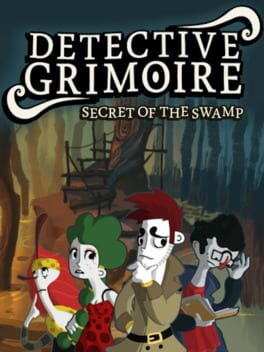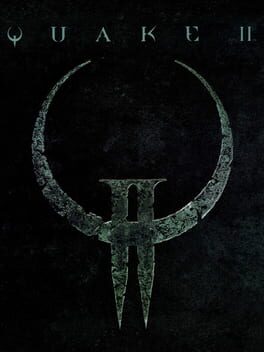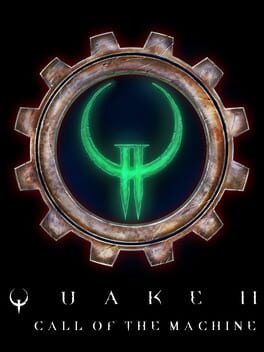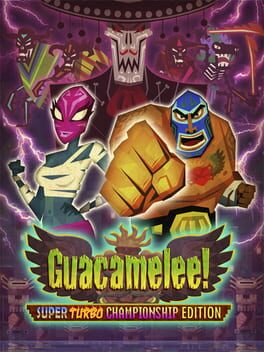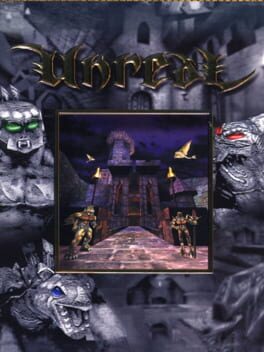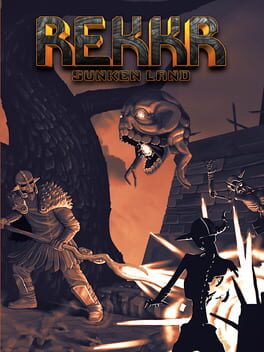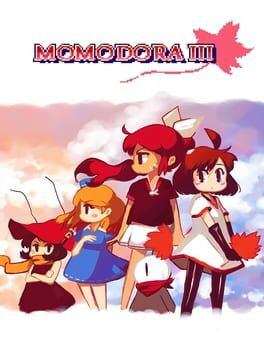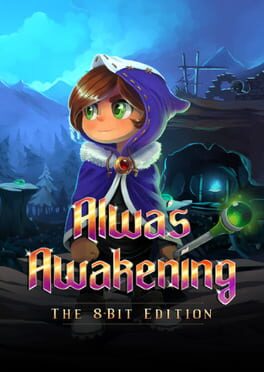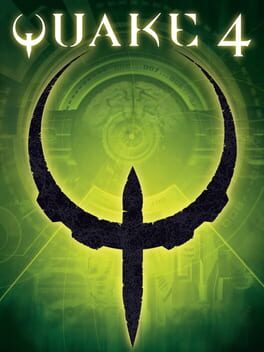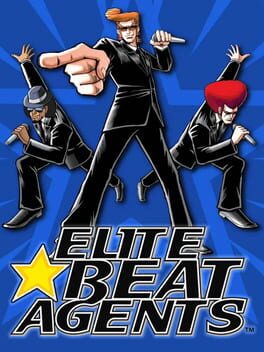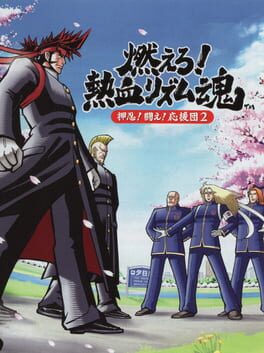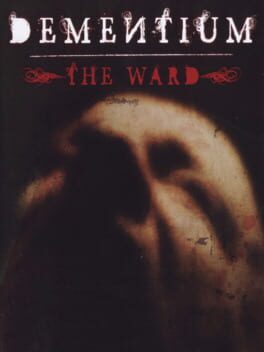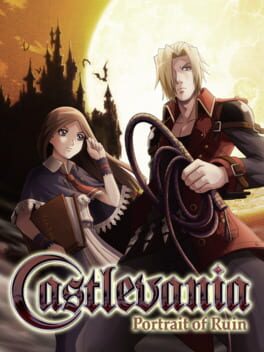iv1632
Very short and to the point game with charming art direction, great voice acting, sound design and music, and decent exploration.
Unfortunately it falls short on puzzles, as none of them really make you think that much, the characters don't get much time to develop and figuring out who the murderer is ends up being too predictable. Luckily, there's more to this mystery than that, and piecing it together with Tangle Tower (which I unfortunately played first) definitely builds up something interesting. I hope we get to see more of this world soon.
Unfortunately it falls short on puzzles, as none of them really make you think that much, the characters don't get much time to develop and figuring out who the murderer is ends up being too predictable. Luckily, there's more to this mystery than that, and piecing it together with Tangle Tower (which I unfortunately played first) definitely builds up something interesting. I hope we get to see more of this world soon.
2023
The original Quake II is a bit of a divisive game, often compared to its older Quake sibling and regarded as not nearly as impressive, varied or fun. If you think of the original game like this then the remaster may help you finally like it.
Presentation-wise, this remaster was done by porting the game over to a specialized KEX Engine, expanding the level of detail possible in lighting and models along the way. The new lighting and shadow effects are really good and they manage to keep the original atmosphere without being nearly as dull. Audio has been greatly enhanced as well, with footsteps taking into account the material you're on and rooms having reverb for better immersion.
In terms of gameplay, this is where the remaster adds the most to the game. Weapons now have near instant switching, muzzle flashes, and small rebalances like removing the recoil mechanic from the machinegun, gunplay is leagues more satisfying as a result. They have gone back and added cut content to the levels and enemies, updating the AI (which had already been updated with an expansion) to make it smarter and give enemies a wider variety of behaviors and attacks based on unfinished code. Enemies can now follow you by jumping and what were previously very harmless enemies like the common grunts or the Berserker are now a force to be reckoned with when you're not paying attention. The Berserker probably has the most notorious change, having a charged jump attack that can send you flying.
The smarter and more aggressive enemy AI completely changes the game, as you are now strategizing way more to avoid being damaged and probably getting forced into using your items and different guns more often. Unlike my previous playthroughs, I no longer spent a lot of time just shooting the super shotgun while hiding behind walls, as that strategy has become nearly useless. This is a good bump in difficulty that actually makes the game way more engaging and I welcome this change completely.
Some smaller gameplay changes include an item and weapon wheel, with the item wheel in particular making inventory management much better, a compass that helps with navigation by giving you a waypoint and drawing a path on the floor, as well as making the Nightmare difficulty official and accessible on a new game.
Add onto everything that you get all expansions, a new one, and the Nintendo 64 levels, alongside a much more convenient multiplayer setup with official co-op support, plus an extras menu full of development content and playable demos, extensive accessibility options, and we got the best possible remaster this game could have gotten. Everything that was added wasn't necessary at all to do, but they did it, and they worked even harder for a game that people often dismiss when compared to its predecessors. My only nitpick is that I wish I could toggle the gameplay changes back, mainly the machinegun recoil, but I can't complain about the changes being bad at all and the original isn't going anywhere either.
This is the definitive Quake II experience and I'd definitely recommend reading this blog post on Bethesda's site where they explain the engine changes in more detail just to appreciate how much work went into this, because it's a lot, and very much worth playing the game for.
Presentation-wise, this remaster was done by porting the game over to a specialized KEX Engine, expanding the level of detail possible in lighting and models along the way. The new lighting and shadow effects are really good and they manage to keep the original atmosphere without being nearly as dull. Audio has been greatly enhanced as well, with footsteps taking into account the material you're on and rooms having reverb for better immersion.
In terms of gameplay, this is where the remaster adds the most to the game. Weapons now have near instant switching, muzzle flashes, and small rebalances like removing the recoil mechanic from the machinegun, gunplay is leagues more satisfying as a result. They have gone back and added cut content to the levels and enemies, updating the AI (which had already been updated with an expansion) to make it smarter and give enemies a wider variety of behaviors and attacks based on unfinished code. Enemies can now follow you by jumping and what were previously very harmless enemies like the common grunts or the Berserker are now a force to be reckoned with when you're not paying attention. The Berserker probably has the most notorious change, having a charged jump attack that can send you flying.
The smarter and more aggressive enemy AI completely changes the game, as you are now strategizing way more to avoid being damaged and probably getting forced into using your items and different guns more often. Unlike my previous playthroughs, I no longer spent a lot of time just shooting the super shotgun while hiding behind walls, as that strategy has become nearly useless. This is a good bump in difficulty that actually makes the game way more engaging and I welcome this change completely.
Some smaller gameplay changes include an item and weapon wheel, with the item wheel in particular making inventory management much better, a compass that helps with navigation by giving you a waypoint and drawing a path on the floor, as well as making the Nightmare difficulty official and accessible on a new game.
Add onto everything that you get all expansions, a new one, and the Nintendo 64 levels, alongside a much more convenient multiplayer setup with official co-op support, plus an extras menu full of development content and playable demos, extensive accessibility options, and we got the best possible remaster this game could have gotten. Everything that was added wasn't necessary at all to do, but they did it, and they worked even harder for a game that people often dismiss when compared to its predecessors. My only nitpick is that I wish I could toggle the gameplay changes back, mainly the machinegun recoil, but I can't complain about the changes being bad at all and the original isn't going anywhere either.
This is the definitive Quake II experience and I'd definitely recommend reading this blog post on Bethesda's site where they explain the engine changes in more detail just to appreciate how much work went into this, because it's a lot, and very much worth playing the game for.
Very well designed maps that are honestly elevated by the fact that they're for Quake II, we don't have nearly as many quality community maps for Quake II as the original Quake and having an official modern expansion, which also feels like a very high quality community project like we get on other games, filled with varied maps that with exploring take way longer to finish than the main game, it's a great deal.
Some of the maps take more from the original Quake, having mostly ambient sound and a horror atmosphere. I'm honestly not as big of a fan of this as most, but you Quake I lovers may appreciate it a lot.
I managed to find all the secret levels and they're great fun, most of them are labeled as "Trials" where you're thrown into a small map full of enemies to take on a big firefight or two, with your reward for going through them being ammo upgrades and power-ups, making it very worth it.
If I have to complain about something it'd be the boss fights being about as unremarkable as those in the base game, although having a visible health bar does make it feel like they drag way less, so we have that. I'm also not really a big fan of what they do with the ending, if you know you know and probably think I'm insane for this.
Overall though this was a good amount of fun, while this expansion is considerably challenging and does throw more enemies at you than the base game ever would, you're never missing the tools to deal with them and this pack would be something I'd be willing to pay for on its own, worth your time if you like the game.
Some of the maps take more from the original Quake, having mostly ambient sound and a horror atmosphere. I'm honestly not as big of a fan of this as most, but you Quake I lovers may appreciate it a lot.
I managed to find all the secret levels and they're great fun, most of them are labeled as "Trials" where you're thrown into a small map full of enemies to take on a big firefight or two, with your reward for going through them being ammo upgrades and power-ups, making it very worth it.
If I have to complain about something it'd be the boss fights being about as unremarkable as those in the base game, although having a visible health bar does make it feel like they drag way less, so we have that. I'm also not really a big fan of what they do with the ending, if you know you know and probably think I'm insane for this.
Overall though this was a good amount of fun, while this expansion is considerably challenging and does throw more enemies at you than the base game ever would, you're never missing the tools to deal with them and this pack would be something I'd be willing to pay for on its own, worth your time if you like the game.
When it comes to the Metroidvania genre, there's many games that are put in there which aren't really close to Metroid or Castlevania. This game is extremely close to Metroid, if Metroid got a really silly parody with a luchador that can do extremely powerful melee attacks rather than attack with a cannon.
The main path is pretty linear, but you get plenty of opportunities to branch off to get items or complete side quests, which is very rewarding. As you progress through the game you'll unlock new moves that are useful for both combat and movement, eventually being able to dish out so much damage when paired with other upgrades that makes the combat really satisfying. As it is the case with many good combat systems, it's pretty simple in concept but you'll need a decent amount of strategy and skill to keep up your combos.
I don't know how this compares to the other editions of the game, but I had a lot of fun with this. If you like Metroid then there's no reason not to play this.
The main path is pretty linear, but you get plenty of opportunities to branch off to get items or complete side quests, which is very rewarding. As you progress through the game you'll unlock new moves that are useful for both combat and movement, eventually being able to dish out so much damage when paired with other upgrades that makes the combat really satisfying. As it is the case with many good combat systems, it's pretty simple in concept but you'll need a decent amount of strategy and skill to keep up your combos.
I don't know how this compares to the other editions of the game, but I had a lot of fun with this. If you like Metroid then there's no reason not to play this.
Another remarkable remaster from Nightdive, but I really want to commend NewBlood for their contributions as well. NewBlood focused on restoring the cut enemies, putting together the new episode and working on QoL features like the extra HUD, which really elevates this remaster as an ultimate edition.
The new episode is great if you're into ROTT's brand of level design and uses some more advanced features as well as taking advantage of the verticality that's possible with the jump pads and platforms of the game. I am surprised at how flexible KEX is sometimes, everything in this feels right, from the rendering to the movement. I don't love ROTT nearly as much as other people do but asides from a near complete overhaul like the Quake II remaster, which I feel like would just mess up the personality of this game, there's nothing more I could ask from this.
It's true that nobody loves ROTT more than NewBlood and Nightdive and I'm really glad they're the ones who got their hands on this after it got taken away from 3DR, if you're a fan you can't miss this release. Not completed cause I'm not playing Extreme ROTT.
The new episode is great if you're into ROTT's brand of level design and uses some more advanced features as well as taking advantage of the verticality that's possible with the jump pads and platforms of the game. I am surprised at how flexible KEX is sometimes, everything in this feels right, from the rendering to the movement. I don't love ROTT nearly as much as other people do but asides from a near complete overhaul like the Quake II remaster, which I feel like would just mess up the personality of this game, there's nothing more I could ask from this.
It's true that nobody loves ROTT more than NewBlood and Nightdive and I'm really glad they're the ones who got their hands on this after it got taken away from 3DR, if you're a fan you can't miss this release. Not completed cause I'm not playing Extreme ROTT.
1998
This was a surprising game for me in many ways. The game starts out in a decently atmospheric intro level where you find yourself escaping a crashed prison spaceship, lacking weapons, can read logs and notes from all the dead people and abandoned computers around you and get the chance to pick up the pieces to get some context for the story. Eventually when stepping out into the planet, the gigantic scale of the map, the ambient sounds coming from the animals and environment and the sense of exploration were incredible.
Many maps in this game have an incredible scale for 1998, and even when things are crude, a lot of thought goes into the world building be it through readable logs or simply environmental details. You could call the visuals outdated, but I find that they're artistically used very well to convey the environment so that I could keep myself immersed even when details are lacking, especially thanks to some great use of lighting effects. Some of the scenes visible in this game are simply unbelievable to me and I can't imagine what seeing them in a period accurate PC at the time would have been like.
Combat is certainly an aspect that will put a lot of people off, they focused on building an AI system that would give enemies the ability to navigate maps extensively, dodge your attacks and even have some types use a variety of weapons. I'm guessing that due to optimization, they kept combat spaces to very few enemies at a time which does mean enemies are designed around being a bit tanky so you often have a dynamic 1v1 encounter. When it works it's pretty fine, if a bit slower paced than other games in the genre at the time, but when it doesn't work it feels like enemies are either always dodging or getting lost, with the level design in later areas not helping much as it gets more mazey.
And this is where the game fell out of legendary status for me, the jank felt pretty justifiable given its age and how much it accomplished at the time a mere 5 months after Quake II had tried to do a lot of it and didn't quite reach, but the final 2 chapters are extremely tedious. Level design goes from trying to immerse into big open maps that lead you to smaller places you can explore to being very mazey and in some cases a messy kind of symmetrical, with very strange design choices like waiting for 2 enemies to constantly spawn after being killed until they spawn behind a door, with no indication, so that door finally opens and you can proceed. Already I felt like the game was simply stretching thin before this as it ran out of weapons and enemies to introduce, but the final chapter had me WISHING the game ended in every single map I had to go through. It didn't help that boss fights are the typical FPS trope of shoot at it until it dies.
I don't mind Half-Life Xen as much as other people do, I find it kinda boring but not frustrating. The final chapter of Unreal was frustating for me, not because it had weird gravity gimmicks or because I died much or anything of the sort, but because the levels and enemy encounters were really unengaging and uninteresting at that point. As even story logs became rare, I felt like the game should have ended 2 or 3 hours ago already. I do not think getting bang for your buck in game length is worth it if the game isn't offering more fun, just more filler. At the very least Xen was filled with interesting ideas and Half-Life wasn't as long.
Still with the problems I had at the end I'm very glad I played this, I still find it an impressive title full of memorable places to explore and a surprisingly thought out world. I just wish it wasn't stretched so much at the end, but regardless, it is a good game and it's a shame that Epic cannot see it for what it is and would rather delist it because they refuse to provide support the community is more than happy to do for them, even while being unpaid.
Many maps in this game have an incredible scale for 1998, and even when things are crude, a lot of thought goes into the world building be it through readable logs or simply environmental details. You could call the visuals outdated, but I find that they're artistically used very well to convey the environment so that I could keep myself immersed even when details are lacking, especially thanks to some great use of lighting effects. Some of the scenes visible in this game are simply unbelievable to me and I can't imagine what seeing them in a period accurate PC at the time would have been like.
Combat is certainly an aspect that will put a lot of people off, they focused on building an AI system that would give enemies the ability to navigate maps extensively, dodge your attacks and even have some types use a variety of weapons. I'm guessing that due to optimization, they kept combat spaces to very few enemies at a time which does mean enemies are designed around being a bit tanky so you often have a dynamic 1v1 encounter. When it works it's pretty fine, if a bit slower paced than other games in the genre at the time, but when it doesn't work it feels like enemies are either always dodging or getting lost, with the level design in later areas not helping much as it gets more mazey.
And this is where the game fell out of legendary status for me, the jank felt pretty justifiable given its age and how much it accomplished at the time a mere 5 months after Quake II had tried to do a lot of it and didn't quite reach, but the final 2 chapters are extremely tedious. Level design goes from trying to immerse into big open maps that lead you to smaller places you can explore to being very mazey and in some cases a messy kind of symmetrical, with very strange design choices like waiting for 2 enemies to constantly spawn after being killed until they spawn behind a door, with no indication, so that door finally opens and you can proceed. Already I felt like the game was simply stretching thin before this as it ran out of weapons and enemies to introduce, but the final chapter had me WISHING the game ended in every single map I had to go through. It didn't help that boss fights are the typical FPS trope of shoot at it until it dies.
I don't mind Half-Life Xen as much as other people do, I find it kinda boring but not frustrating. The final chapter of Unreal was frustating for me, not because it had weird gravity gimmicks or because I died much or anything of the sort, but because the levels and enemy encounters were really unengaging and uninteresting at that point. As even story logs became rare, I felt like the game should have ended 2 or 3 hours ago already. I do not think getting bang for your buck in game length is worth it if the game isn't offering more fun, just more filler. At the very least Xen was filled with interesting ideas and Half-Life wasn't as long.
Still with the problems I had at the end I'm very glad I played this, I still find it an impressive title full of memorable places to explore and a surprisingly thought out world. I just wish it wasn't stretched so much at the end, but regardless, it is a good game and it's a shame that Epic cannot see it for what it is and would rather delist it because they refuse to provide support the community is more than happy to do for them, even while being unpaid.
2021
REKKR as a game had the goal to be a game that could potentially launch in 1996, as shown by its website used for the original release, stylized as if it comes from the time in which web browsers barely had features and could only load things very slowly, As such, this game is NOT built on GZDoom tech at its core, rather using its features as optional extras, but uses the old DEHACKED for the vanilla 1993 DOOM release. The original DOOM engine is way more limited than most think, and DEHACKED only allows you to basically swap values around without being able to really add anything new.
As such, it is amazing that this game feels like more than a DOOM reskin or clone. Things certainly play into the DOOM archetypes but many clever design choices like having the punch be a combo, the axe be a powerful swing, the rune launcher be like a mine launcher, enemies being less about hitscan and more about quick projectiles, really makes it feel like something that was more inspired by DOOM rather than something simply built on it.
The maps are a great part of what makes this game more unique, they have tons of variety and detail that you didn't see in DOOM, but without breaking the limits of its engine, sometimes to the point of it being unbelievable. Levels are usually designed really well, with tons to explore and wrapping around into themselves, maybe even mixing themes and always having enemies push you around, all this being especially true on the Sunken Land episode. The game overall has an artstyle that's inspired by norse-celtic fantasy while still having many unique characteristics, and takes advantage of how much this theme can be pushed as you progress. When paired with the fitting soundtrack, the game gets an unique feel that you don't find in anything else.
My only complaints would be that a late stretch of episode 1 and then a bit of episode 2 drag on, but also that this release uses GZDoom. It actually uses the engine well for what is packaging a game that wasn't primarily built for it, being given a bunch of graphical presets that take you from and in between the extremes of vanilla doom and modern GZDoom with extra effects, also being able to tweak it if you prefer. My problem with this release is that it turned the game files into a PWAD unless using GZDoom, meaning to play on any other port takes a fair bit more work and requires the use of DOOM as a base, losing the stand-alone aspect. This engine package also seems to create expectations that the game will have the advanced features of many GZD contemporaries which may lead to disappointment. Regardless, I can't complain about how the game is packaged otherwise and the new episode, being the most polished while being 3 hours of game when only being 1/4th of the package, is worth the price alone.
This game delivers on its premise of bringing an unique experience that could have been created in the years where this genre was getting the motion for mainstream success while also not feeling like a simple clone of whatever was done in that era, it makes its limitations work in its favor and gives you something that you'll really only appreciate if you know how these games function, I really wish we could get more of this kind of game.
As such, it is amazing that this game feels like more than a DOOM reskin or clone. Things certainly play into the DOOM archetypes but many clever design choices like having the punch be a combo, the axe be a powerful swing, the rune launcher be like a mine launcher, enemies being less about hitscan and more about quick projectiles, really makes it feel like something that was more inspired by DOOM rather than something simply built on it.
The maps are a great part of what makes this game more unique, they have tons of variety and detail that you didn't see in DOOM, but without breaking the limits of its engine, sometimes to the point of it being unbelievable. Levels are usually designed really well, with tons to explore and wrapping around into themselves, maybe even mixing themes and always having enemies push you around, all this being especially true on the Sunken Land episode. The game overall has an artstyle that's inspired by norse-celtic fantasy while still having many unique characteristics, and takes advantage of how much this theme can be pushed as you progress. When paired with the fitting soundtrack, the game gets an unique feel that you don't find in anything else.
My only complaints would be that a late stretch of episode 1 and then a bit of episode 2 drag on, but also that this release uses GZDoom. It actually uses the engine well for what is packaging a game that wasn't primarily built for it, being given a bunch of graphical presets that take you from and in between the extremes of vanilla doom and modern GZDoom with extra effects, also being able to tweak it if you prefer. My problem with this release is that it turned the game files into a PWAD unless using GZDoom, meaning to play on any other port takes a fair bit more work and requires the use of DOOM as a base, losing the stand-alone aspect. This engine package also seems to create expectations that the game will have the advanced features of many GZD contemporaries which may lead to disappointment. Regardless, I can't complain about how the game is packaged otherwise and the new episode, being the most polished while being 3 hours of game when only being 1/4th of the package, is worth the price alone.
This game delivers on its premise of bringing an unique experience that could have been created in the years where this genre was getting the motion for mainstream success while also not feeling like a simple clone of whatever was done in that era, it makes its limitations work in its favor and gives you something that you'll really only appreciate if you know how these games function, I really wish we could get more of this kind of game.
2014
Really nice small game, it's a good follow up to the earlier Momodora games while standing on its own. You get 2 playable characters, with one having more health, while also a bunch of different difficulty options which when combined with your 3 inventory slots and items you collect can all shape the game differently. Depending on what you choose, this game can be easy or hard, so its worth to keep in mind what you'd want to do with that before playing.
While the general structure is linear, having a game with 100% completion will take some going off the beating path and talking to characters. Your initial playthrough will only take around an hour, but you can play the game again to complete all achievements or find something you missed, which doesn't feel like a chore when a regular play doesn't take too long so I'll be working on getting what I missed.
This game is pretty cheap and doesn't stretch itself too long with filler, which I really consider a positive as what the game has is good on its own and doesn't have noticeably elongated lows. I do recommend it alongside the rest of the series.
While the general structure is linear, having a game with 100% completion will take some going off the beating path and talking to characters. Your initial playthrough will only take around an hour, but you can play the game again to complete all achievements or find something you missed, which doesn't feel like a chore when a regular play doesn't take too long so I'll be working on getting what I missed.
This game is pretty cheap and doesn't stretch itself too long with filler, which I really consider a positive as what the game has is good on its own and doesn't have noticeably elongated lows. I do recommend it alongside the rest of the series.
Do I love seeing games that make their limitations work and this is a nice example of it. I don't know how the 8-Bit Edition compares to the original Unity build, but apparently it even has more content. (Now I know, and I honestly prefer the 8-bit edition because of how at home it feels)
This is a metroidvania mainly focused on its exploration and platforming, with tight controls, good music and nicely detailed graphics for an NES game.
The exploration in particular is really well done, there's a diverse amount of areas with different tilesets and music that house a lot of paths that you will need different abilities to get through, which of course are found by exploring. They're simple stuff like making blocks or bubbles that you can stand on or shooting a bolt, but the former two are especially geared towards your navigation. The blocks and bubbles can be upgraded to make them more versatile and open a lot more of the map, which any good metroidvania has to do. Backtracking didn't feel like a chore, probably helped by the fact that the game isn't too long.
The only aspect where this game is most simplistic is its combat, as enemies are usually just the type that walk left and right, stand and shoot, or do both. Boss fights are pretty simple as well, focused on big attacks but with patterns that you can learn to avoid. None of this is really surprising for a game that's being authentic to what you'd get in the 80s, so I do appreciate how it works without being frustrating.
There's one particular aspect that may make this game very frustrating, especially on the final areas: it's full of instant death traps. Be it spikes, fire, liquids or whatever, these will kill you in one hit and send you back to the last save point. The save points are pretty merciful however, as they're more like resume points that you go back to after dying, so if you die after grabbing an item or unlocking a door you don't actually lose that progress, and I even found myself exploiting this to "fast travel" at some points, wonder if speedrunning uses this mechanic. If you find it too frustrating, the options offer an assist mode that makes you respawn in the same room that you died in, or you could use save states assuming you play on an emulator, which you're likely to do as the physical release is limited.
I really appreciate how they managed to craft something that both feels fresh but also like it really belongs in the console, and it's mostly based on a game they first made on Unity just keeping in mind what limitations would be in place in 8-Bits and I'm glad that they ported it over eventually. If you're not into these kind of games then I think this is a good entry point, and if you do like these, this is a must play. It doesn't use cheap tricks like giant difficulty spikes or anything because it doesn't need to, it's just a meaty package for retro fans.
This is a metroidvania mainly focused on its exploration and platforming, with tight controls, good music and nicely detailed graphics for an NES game.
The exploration in particular is really well done, there's a diverse amount of areas with different tilesets and music that house a lot of paths that you will need different abilities to get through, which of course are found by exploring. They're simple stuff like making blocks or bubbles that you can stand on or shooting a bolt, but the former two are especially geared towards your navigation. The blocks and bubbles can be upgraded to make them more versatile and open a lot more of the map, which any good metroidvania has to do. Backtracking didn't feel like a chore, probably helped by the fact that the game isn't too long.
The only aspect where this game is most simplistic is its combat, as enemies are usually just the type that walk left and right, stand and shoot, or do both. Boss fights are pretty simple as well, focused on big attacks but with patterns that you can learn to avoid. None of this is really surprising for a game that's being authentic to what you'd get in the 80s, so I do appreciate how it works without being frustrating.
There's one particular aspect that may make this game very frustrating, especially on the final areas: it's full of instant death traps. Be it spikes, fire, liquids or whatever, these will kill you in one hit and send you back to the last save point. The save points are pretty merciful however, as they're more like resume points that you go back to after dying, so if you die after grabbing an item or unlocking a door you don't actually lose that progress, and I even found myself exploiting this to "fast travel" at some points, wonder if speedrunning uses this mechanic. If you find it too frustrating, the options offer an assist mode that makes you respawn in the same room that you died in, or you could use save states assuming you play on an emulator, which you're likely to do as the physical release is limited.
I really appreciate how they managed to craft something that both feels fresh but also like it really belongs in the console, and it's mostly based on a game they first made on Unity just keeping in mind what limitations would be in place in 8-Bits and I'm glad that they ported it over eventually. If you're not into these kind of games then I think this is a good entry point, and if you do like these, this is a must play. It doesn't use cheap tricks like giant difficulty spikes or anything because it doesn't need to, it's just a meaty package for retro fans.
2005
A few days ago I was looking at the Quake games on Steam and realized something: I had not only not played Q4 since I was very young and I also happened to remember pretty much none of it, not even that much of the cutscene everyone knows this for. I was in the mood for something quick to play so I installed it and gave it another go.
From the beginning this game gives off DOOM 3 vibes more than anything, except the horror atmosphere isn't the focus, guns feel punchier and action is almost immediate.
Already an hour in I was feeling like this game was utilizing the idtech 4 engine way better, as it had a lot of pretty lighting in detailed areas with rich textures, but without making things overly dark and also making levels more fast paced. Sure, the initial walking speed is a bit annoyingly slow, but the levels are designed in such a way that I never felt too slow even while backtracking.
I think there's something to be said about the presentation of this game, the story continues right from the ending of Quake II and follows a silent protagonist alongside a squad of veteran soldiers. None of the characters are very deep or noteworthy, but they have some good voice work and the showing of different squads advancing through Stroggos in coordinated assaults gives a more natural tone of war that was absent in Quake II. The Strogg are designed in more interesting ways as well, giving us new foes with gruesome character design and a bunch of returning enemies a new spin, like the Berserkers having lighting attacks or the Iron Maidens being able to teleport and float. In general enemies use a wider variety of weapons as well, making them less monotonous when encountering the same enemy type. Unfortunately the Strogg still look too human like to my liking, with not many indications of them really being a galactic civilization that existed away from humans for a long time, but that problem is inherited from Quake II and not a particular issue with this game.
Unfortunately the AI isn't all that great, enemies have pretty predictable behaviors and ally squad members aren't always good at following you or finding a good spot, however levels are also designed well enough around this and will rarely show these weaknesses to a big degree.
Speaking of ally squad members, they're honestly nice to have around but aren't too much of a big deal. They do mostly stay alive without your supervision but can still die so it's a bad idea to let big enemies get a hold of them. A few sections with them are actually tricky to manage while trying to keep everyone alive which I welcome. They'll also provide you with weapon upgrades throughout the game, a system that's very clearly a last minute addition but helps the pacing as you get new reasons to use your weapons.
Weapons themselves all feel great, they all are good options during firefights and can still serve different roles. Of note are the lighting gun and nail gun which return, redesigned, from the first Quake game and the very versatile assault rifle and shotgun. Disappointingly the rail gun requires an upgrade to pierce enemies and the SSG is not here, but the arsenal is very robust and feels powerful which is what matters.
Going on, the game has a big moment in the middle which we all know as the Stroggification scene. I am not as impacted by it as others, but getting turned gives you a boost to player speed, health and armor. After this the game really picks up and gets more confident in throwing big enemies in higher numbers at you, which creates a lot of intense combat arenas that are very fun to get through.
The only points in which the pacing of the game is really bogged down is by the vehicle sections. I don't find them frustrating at all and at moments they're a good show, but they feel completely unnecessary and I would not miss them if they were cut. Polishing up the weapon upgrade system or getting more enemy variety could have been a better use of resources than the vehicles, but still, they're at least over quickly and I don't find them to ruin the game.
The final stretch of the game is the most fast paced and action heavy part and I really love it, it feels like the Strogg are giving way too much attention to you as an individual due to how much you're foiling their plans and it's great. The final boss is a pushover just like with Quake II, but at least it's harder to cheese as you can't just pop out a Quad Damage and Invulnerability to get through it quick.
Overall it's a pretty polished game that doesn't feel like it wastes my time. Despite being very derivative of Quake II and DOOM 3 I think it does a bunch of things better than those, particularly just being way better at pacing than DOOM 3 ever was, and is overall a very polished experience. It's maybe not one of the greats or as historically significant but it's still a good time and it has aged very well. Take it from someone that has a lot of nostalgia for Halo: it does not at all feel like Halo or CoD as some say, it really just feels like something that would naturally come after DOOM 3 mixed in with Quake II and I enjoy that a fair bit.
From the beginning this game gives off DOOM 3 vibes more than anything, except the horror atmosphere isn't the focus, guns feel punchier and action is almost immediate.
Already an hour in I was feeling like this game was utilizing the idtech 4 engine way better, as it had a lot of pretty lighting in detailed areas with rich textures, but without making things overly dark and also making levels more fast paced. Sure, the initial walking speed is a bit annoyingly slow, but the levels are designed in such a way that I never felt too slow even while backtracking.
I think there's something to be said about the presentation of this game, the story continues right from the ending of Quake II and follows a silent protagonist alongside a squad of veteran soldiers. None of the characters are very deep or noteworthy, but they have some good voice work and the showing of different squads advancing through Stroggos in coordinated assaults gives a more natural tone of war that was absent in Quake II. The Strogg are designed in more interesting ways as well, giving us new foes with gruesome character design and a bunch of returning enemies a new spin, like the Berserkers having lighting attacks or the Iron Maidens being able to teleport and float. In general enemies use a wider variety of weapons as well, making them less monotonous when encountering the same enemy type. Unfortunately the Strogg still look too human like to my liking, with not many indications of them really being a galactic civilization that existed away from humans for a long time, but that problem is inherited from Quake II and not a particular issue with this game.
Unfortunately the AI isn't all that great, enemies have pretty predictable behaviors and ally squad members aren't always good at following you or finding a good spot, however levels are also designed well enough around this and will rarely show these weaknesses to a big degree.
Speaking of ally squad members, they're honestly nice to have around but aren't too much of a big deal. They do mostly stay alive without your supervision but can still die so it's a bad idea to let big enemies get a hold of them. A few sections with them are actually tricky to manage while trying to keep everyone alive which I welcome. They'll also provide you with weapon upgrades throughout the game, a system that's very clearly a last minute addition but helps the pacing as you get new reasons to use your weapons.
Weapons themselves all feel great, they all are good options during firefights and can still serve different roles. Of note are the lighting gun and nail gun which return, redesigned, from the first Quake game and the very versatile assault rifle and shotgun. Disappointingly the rail gun requires an upgrade to pierce enemies and the SSG is not here, but the arsenal is very robust and feels powerful which is what matters.
Going on, the game has a big moment in the middle which we all know as the Stroggification scene. I am not as impacted by it as others, but getting turned gives you a boost to player speed, health and armor. After this the game really picks up and gets more confident in throwing big enemies in higher numbers at you, which creates a lot of intense combat arenas that are very fun to get through.
The only points in which the pacing of the game is really bogged down is by the vehicle sections. I don't find them frustrating at all and at moments they're a good show, but they feel completely unnecessary and I would not miss them if they were cut. Polishing up the weapon upgrade system or getting more enemy variety could have been a better use of resources than the vehicles, but still, they're at least over quickly and I don't find them to ruin the game.
The final stretch of the game is the most fast paced and action heavy part and I really love it, it feels like the Strogg are giving way too much attention to you as an individual due to how much you're foiling their plans and it's great. The final boss is a pushover just like with Quake II, but at least it's harder to cheese as you can't just pop out a Quad Damage and Invulnerability to get through it quick.
Overall it's a pretty polished game that doesn't feel like it wastes my time. Despite being very derivative of Quake II and DOOM 3 I think it does a bunch of things better than those, particularly just being way better at pacing than DOOM 3 ever was, and is overall a very polished experience. It's maybe not one of the greats or as historically significant but it's still a good time and it has aged very well. Take it from someone that has a lot of nostalgia for Halo: it does not at all feel like Halo or CoD as some say, it really just feels like something that would naturally come after DOOM 3 mixed in with Quake II and I enjoy that a fair bit.
2006
Some boys kiss me, some boys hug me
I think they're OK
If they don't give me proper credit, I just walk away
They can beg and they can plead
But they can't see the light (that's right, that's right)
'Cause the boy with the cold hard cash is always Mister Right
'Cause we are living in a material world
And I am a material girl
You know that we are living in a material world
And I am a material girl
Some boys romance, some boys slow dance
That's all right with me
If they can't raise my interest, then I have to let them be
Some boys try, and some boys lie
But I don't let them play (no way, no way)
Only boys that save their pennies make my rainy day
'Cause we are living in a material world
And I am a material girl
You know that we are living in a material world
And I am a material girl
Living in a material world
And I am a material girl
You know that we are living in a material world
And I am a material girl
Living in a material world (material)
Living in a material world
Living in a material world (material)
Living in a material world
Boys may come, and boys may go
And that's all right, you see
Experience has made me rich, and now they're after me
'Cause everybody's living in a material world
And I am a material girl
You know that we are living in a material world
And I am a material girl
Living in a material world
And I am a material girl
You know that we are living in a material world
And I am a material girl
A material, a material, a material, a material world
Living in a material world (material)
Living in a material world
Living in a material world (material)
Living in a material world
Living in a material world (material)
Living in a material world
Living in a material world (material)
Living in a material world
I think they're OK
If they don't give me proper credit, I just walk away
They can beg and they can plead
But they can't see the light (that's right, that's right)
'Cause the boy with the cold hard cash is always Mister Right
'Cause we are living in a material world
And I am a material girl
You know that we are living in a material world
And I am a material girl
Some boys romance, some boys slow dance
That's all right with me
If they can't raise my interest, then I have to let them be
Some boys try, and some boys lie
But I don't let them play (no way, no way)
Only boys that save their pennies make my rainy day
'Cause we are living in a material world
And I am a material girl
You know that we are living in a material world
And I am a material girl
Living in a material world
And I am a material girl
You know that we are living in a material world
And I am a material girl
Living in a material world (material)
Living in a material world
Living in a material world (material)
Living in a material world
Boys may come, and boys may go
And that's all right, you see
Experience has made me rich, and now they're after me
'Cause everybody's living in a material world
And I am a material girl
You know that we are living in a material world
And I am a material girl
Living in a material world
And I am a material girl
You know that we are living in a material world
And I am a material girl
A material, a material, a material, a material world
Living in a material world (material)
Living in a material world
Living in a material world (material)
Living in a material world
Living in a material world (material)
Living in a material world
Living in a material world (material)
Living in a material world
I miss this series dearly. EBA + Ouendan are the peak of rhythm games for me, sure we got a clone in the form of "Osu!" but since it's more of a platform to make song charts with the same mechanics rather than its own full fledged game it is naturally lacking personality.
Ouendan 1 was a nice albeit unpolished experiment, Elite Beat Agents was a great evolution with QoL improvements and its own particularly charming group of characters with a sillyness aided by the adoption of North American stereotypes that are simply silly and fun.
Unfortunately I find Ouendan 2 to be a bit of a step down from EBA. A few of the songs simply have kinda boring and tedious charts as well as characters that don't always feel as compelling. However, this could be seen as subjective and we have some nice additions like 2 groups of Ouendan which develop a rivalry during the game, which I love seeing clash and then come around. The gameplay is also the most polished its ever been, thanks to this being the final game in the series.
Despite the language barrier, the stories are mostly easy to follow through illustrations that convey the characters pretty well. However, context will still be lost so I'd recommend following along with translations that are up on youtube or gamefaqs. Even if I don't find these as compelling, they still ooze with the signature charm of iNiS at the time and culminate in a great story of finding the drive to keep going in the face of adversity.
I think I wanted to say more but honestly it's just that these games make me so happy: following the troubles of the people in this wacky world and helping them overcome their hardships through song and dance is great satisfaction and fun and makes me kinda feel less alone. Yet again, the songs, writing, illustrations and gameplay all come together in a style that simply can't be replicated. While I'm sad this is the end, I'm very glad it happened and I'll always cherish these games as something to put on when I'm having a hard time to simply find my groove and get lost in for an hour.
The final song is just great. I am not getting over this one.
Ouendan 1 was a nice albeit unpolished experiment, Elite Beat Agents was a great evolution with QoL improvements and its own particularly charming group of characters with a sillyness aided by the adoption of North American stereotypes that are simply silly and fun.
Unfortunately I find Ouendan 2 to be a bit of a step down from EBA. A few of the songs simply have kinda boring and tedious charts as well as characters that don't always feel as compelling. However, this could be seen as subjective and we have some nice additions like 2 groups of Ouendan which develop a rivalry during the game, which I love seeing clash and then come around. The gameplay is also the most polished its ever been, thanks to this being the final game in the series.
Despite the language barrier, the stories are mostly easy to follow through illustrations that convey the characters pretty well. However, context will still be lost so I'd recommend following along with translations that are up on youtube or gamefaqs. Even if I don't find these as compelling, they still ooze with the signature charm of iNiS at the time and culminate in a great story of finding the drive to keep going in the face of adversity.
I think I wanted to say more but honestly it's just that these games make me so happy: following the troubles of the people in this wacky world and helping them overcome their hardships through song and dance is great satisfaction and fun and makes me kinda feel less alone. Yet again, the songs, writing, illustrations and gameplay all come together in a style that simply can't be replicated. While I'm sad this is the end, I'm very glad it happened and I'll always cherish these games as something to put on when I'm having a hard time to simply find my groove and get lost in for an hour.
The final song is just great. I am not getting over this one.
2007
Very impressive title for the DS, it has a great atmosphere with nice sound design, some dynamic lighting and high resolution textures while staying at 60 FPS. Unfortunately the gameplay is just really really boring, I'd even prefer to have no combat over what is there since it's way too clunky. The writing doesn't feel particularly interesting either, so outside of the atmosphere I'm not compelled to keep going.
A little disappointed with this one.
A little disappointed with this one.
Short of Aria of Sorrow Alter this might be my favorite CV up to this point. There's not much grinding to do for money this time, the castle is less of a focus with the locations of the portraits being where most of the action is. there's killer music and bosses are actually engaging to go into.
Technically a lot of the stuff from Dawn of Sorrow is here as well, like 2 sets of items evolving into having 2 separate characters and monsters dropping abilities, except all the annoying touch screen gimmicks are gone and it's just overall more polished.
The castle is both a hub and its own fully fledged map with different areas and bosses, while the portraits are their own maps with distinct themes. This is like if Harmony of Dissonance's two castles mechanic mixed with Lament of Innocence's hub castle, except it's well designed and not confusing here as the pacing maintains itself with focus throughout.
Playing around with both characters is great. Jonathan is focused on more physical attacks and weaponry while Charlotte is focused on magic and spells. Spells can be charged for an extra damage/boost and are very varied in function. You can choose to have both characters out at once or use only one, while there also being a button that calls for the other character to use their special ability. When you mix all different attacks and abilities the game really opens up and it's pretty fun to see how much damage you can dish out with different builds, this is probably the only Castlevania game where I took the weaknesses of enemies into account very often. I miss the soul system from Aria and Dawn a bit, but they certainly cut down on the tedium by balancing these 2 characters instead.
Only big complaint I got is that the generic anime aesthetic and tone is still not gone which unfortunately also has an adverse effect on the story.
Technically a lot of the stuff from Dawn of Sorrow is here as well, like 2 sets of items evolving into having 2 separate characters and monsters dropping abilities, except all the annoying touch screen gimmicks are gone and it's just overall more polished.
The castle is both a hub and its own fully fledged map with different areas and bosses, while the portraits are their own maps with distinct themes. This is like if Harmony of Dissonance's two castles mechanic mixed with Lament of Innocence's hub castle, except it's well designed and not confusing here as the pacing maintains itself with focus throughout.
Playing around with both characters is great. Jonathan is focused on more physical attacks and weaponry while Charlotte is focused on magic and spells. Spells can be charged for an extra damage/boost and are very varied in function. You can choose to have both characters out at once or use only one, while there also being a button that calls for the other character to use their special ability. When you mix all different attacks and abilities the game really opens up and it's pretty fun to see how much damage you can dish out with different builds, this is probably the only Castlevania game where I took the weaknesses of enemies into account very often. I miss the soul system from Aria and Dawn a bit, but they certainly cut down on the tedium by balancing these 2 characters instead.
Only big complaint I got is that the generic anime aesthetic and tone is still not gone which unfortunately also has an adverse effect on the story.
1998
This is such a charming game. The relaxed atmosphere, characters and voice acting are nothing short of adorable. There's a good mix of signature cheesiness and awkwardness in the voices, but also a fair amount of great performances. The anime cutscenes look great too, and I really enjoyed the music as well.
Unfortunately I can't like this as much as I wish I could due to the controls, the analogue movement feels overly sensitive and the d-pad movement just imprecise, as well as only being able to change the height of the camera with a few set values, with it struggling to keep up with you often. This isn't an issue with how simple most of the levels are, but some really focus on platforming and show off this huge flaw, especially the final one.
I still had a pretty good time with this though and it's only 3-4 hours long (took me 4:36), so it's worth playing if you're interested.
Waffle is the best boy!
Unfortunately I can't like this as much as I wish I could due to the controls, the analogue movement feels overly sensitive and the d-pad movement just imprecise, as well as only being able to change the height of the camera with a few set values, with it struggling to keep up with you often. This isn't an issue with how simple most of the levels are, but some really focus on platforming and show off this huge flaw, especially the final one.
I still had a pretty good time with this though and it's only 3-4 hours long (took me 4:36), so it's worth playing if you're interested.
Waffle is the best boy!
